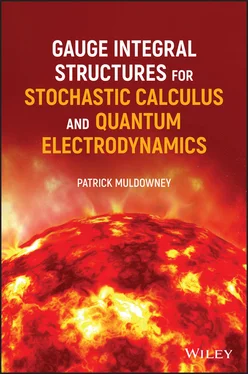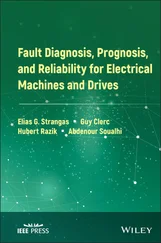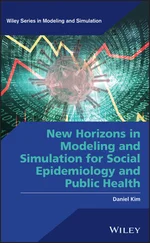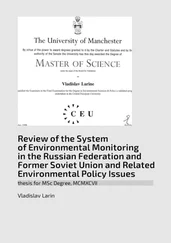Patrick Muldowney - Gauge Integral Structures for Stochastic Calculus and Quantum Electrodynamics
Здесь есть возможность читать онлайн «Patrick Muldowney - Gauge Integral Structures for Stochastic Calculus and Quantum Electrodynamics» — ознакомительный отрывок электронной книги совершенно бесплатно, а после прочтения отрывка купить полную версию. В некоторых случаях можно слушать аудио, скачать через торрент в формате fb2 и присутствует краткое содержание. Жанр: unrecognised, на английском языке. Описание произведения, (предисловие) а так же отзывы посетителей доступны на портале библиотеки ЛибКат.
- Название:Gauge Integral Structures for Stochastic Calculus and Quantum Electrodynamics
- Автор:
- Жанр:
- Год:неизвестен
- ISBN:нет данных
- Рейтинг книги:3 / 5. Голосов: 1
-
Избранное:Добавить в избранное
- Отзывы:
-
Ваша оценка:
Gauge Integral Structures for Stochastic Calculus and Quantum Electrodynamics: краткое содержание, описание и аннотация
Предлагаем к чтению аннотацию, описание, краткое содержание или предисловие (зависит от того, что написал сам автор книги «Gauge Integral Structures for Stochastic Calculus and Quantum Electrodynamics»). Если вы не нашли необходимую информацию о книге — напишите в комментариях, мы постараемся отыскать её.
, left off,
introduces readers to particular problems of integration in the probability-like theory of quantum mechanics. Written as a motivational explanation of the key points of the underlying mathematical theory, and including ample illustrations of the calculus, this book relies heavily on the mathematical theory set out in the author’s previous work. That said, this work stands alone and does not require a reading of
in order to be understandable.
Gauge Integral Structures for Stochastic Calculus and Quantum Electrodynamics Stochastic calculus, including discussions of random variation, integration and probability, and stochastic processes. Field theory, including discussions of gauges for product spaces and quantum electrodynamics. Robust and thorough appendices, examples, illustrations, and introductions for each of the concepts discussed within. An introduction to basic gauge integral theory. The methods employed in this book show, for instance, that it is no longer necessary to resort to unreliable «Black Box» theory in financial calculus; that full mathematical rigor can now be combined with clarity and simplicity. Perfect for students and academics with even a passing interest in the application of the gauge integral technique pioneered by R. Henstock and J. Kurzweil,
is an illuminating and insightful exploration of the complex mathematical topics contained within.


 ,
,  ,
,  , are the particle position co‐ordinates in
, are the particle position co‐ordinates in  for each
for each  .)
.) the domain and its elements are less obvious. In this book the domain
the domain and its elements are less obvious. In this book the domain
 instead of
instead of  for system
for system  ), and also other simplifications which are contrary to physical reality but which make the mathematical exposition a bit easier to follow. An element of this domain is
), and also other simplifications which are contrary to physical reality but which make the mathematical exposition a bit easier to follow. An element of this domain is
 is particle position at time
is particle position at time  ; and, at time
; and, at time  , elements
, elements  and
and  correspond to electromagnetic field components 7at a point
correspond to electromagnetic field components 7at a point  in space. (An element
in space. (An element  is called a historyof the interaction.)
is called a historyof the interaction.) above), further to the challenges already posed by system
above), further to the challenges already posed by system  .
. —or interaction of
—or interaction of  with
with  —posits certain integrands in domain
—posits certain integrands in domain  , the integration being carried out over “all degrees of freedom” of the physical system. But how is an integral on
, the integration being carried out over “all degrees of freedom” of the physical system. But how is an integral on  ,
,  , to be defined? Is there a theory of measurable sets and measurable functions for
, to be defined? Is there a theory of measurable sets and measurable functions for  ? (Even if such a measure‐theoretic integration actually existed it would fail on the requirement for non‐absolute convergence in quantum mechanics.) And if integrands
? (Even if such a measure‐theoretic integration actually existed it would fail on the requirement for non‐absolute convergence in quantum mechanics.) And if integrands  in “
in “  ” involve action functionals of the form
” involve action functionals of the form  , we face the further problem of how to give meaning to “
, we face the further problem of how to give meaning to “  ” as integrand in domain
” as integrand in domain  .
. in a one‐dimensional bounded domain
in a one‐dimensional bounded domain  is defined by means of Riemann sum approximations
is defined by means of Riemann sum approximations  where the subintervals
where the subintervals  of domain
of domain  are formed from partitions such as
are formed from partitions such as










